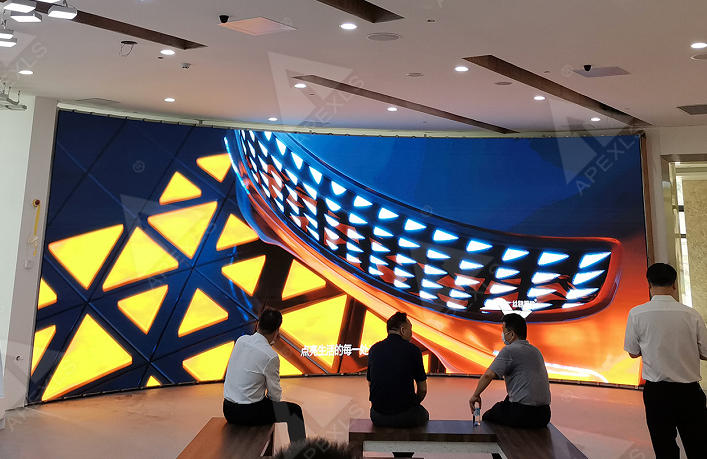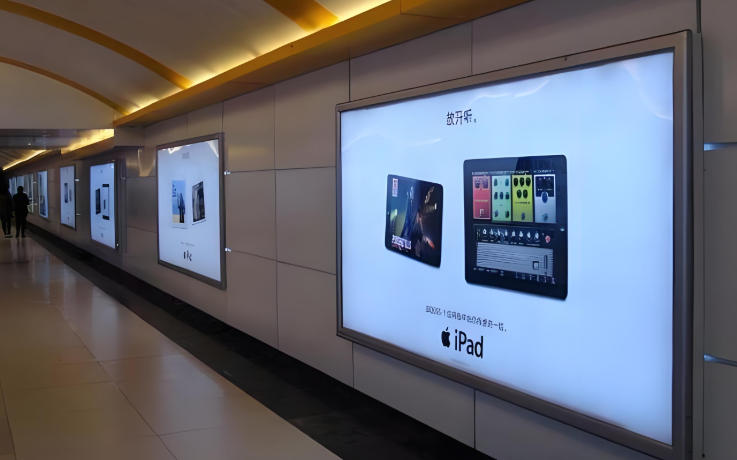
In indoor scenarios such as shopping mall lobbies, office building elevators, and chain storefronts, the choice of advertising format directly impacts brand exposure results and cost investment — should you opt for indoor advertising LED displays that support dynamic video playback and remote content updates, or traditional posters that are low-cost and easy to use? Many businesses struggle with this decision: they want to pursue visual impact but worry about the high upfront cost of LEDs; they consider using posters to control short-term costs, yet are limited by the drawbacks of static content and cumbersome replacement.
Today, Apexls breaks down the differences between these two mainstream indoor advertising formats from three core dimensions — cost, communication effectiveness, and flexibility — to help you find the optimal solution that fits your specific needs.
1. Cost Comparison
The cost structures of the two formats differ significantly: LED displays require high upfront investment but low long-term costs, while the opposite is true for traditional posters.
Comparison Dimension
Indoor Advertising LED Displays & Traditional Posters
Upfront Investment
High. It includes costs for screen hardware, control systems, installation, and commissioning. A small-sized screen (e.g., 1㎡) costs several hundred US dollars, while a large-sized one (e.g., over 10㎡) can reach tens of thousands of US dollars.
Low. Only design fees (several hundred US dollars) and production fees are required. By size, an A0 format costs approximately several tens of US dollars, and large-format inkjet printing costs several tens of US dollars per square meter.
Long-term Costs
Low. Main costs include electricity (a few US dollars per day for small screens, several tens of US dollars for large ones) and minor maintenance fees (e.g., several hundred US dollars per year), with no content replacement costs.
High. Every content update requires re-design and re-production. If replacements are frequent (e.g., once a month), the annual cost may exceed that of a small-sized LED display.
Service Life
Long. The core components have a lifespan of 5-8 years, making the cost more cost-effective when amortized over long-term use.
Short. Paper posters are prone to damage and fading, usually requiring replacement every 1-3 months, leading to high accumulated costs over the long term.

2. Effectiveness Comparison
Indoor LED displays are comprehensively superior to traditional posters in terms of visual impact and information transmission efficiency.
Visual Expression
Indoor LED Displays: Support dynamic videos, GIFs, and image-text switching, with vibrant colors and adjustable brightness to attract more attention. Especially in high-traffic scenarios like shopping malls and office buildings, dynamic content garners 3-5 times more attention than static posters.
Traditional Posters: Only present static images, with limited color expression. They are easily affected by light (e.g., hard to see in dim areas) and have weak visual impact.
Information Transmission Efficiency
Indoor Advertising LED Displays: Can play multiple advertising contents simultaneously or in time-segmented loops, transmitting more information per unit time. Some models also support audio integration to enhance information recall.
Traditional Posters: Each poster can only display one piece of content, with a fixed information capacity. They cannot transmit dynamic or multi-dimensional information.
3. Flexibility Comparison
This is the core advantage of LED displays, and traditional posters are barely comparable in terms of flexibility.
Content Replacement
LED Displays: Content can be updated within minutes via remote control from a computer or mobile phone. Real-time updates (e.g., promotional activities, real-time data) are supported, with no on-site construction required.
Traditional Posters: Replacement requires manual on-site removal of old posters and installation of new ones, which is time-consuming and labor-intensive. Temporary content adjustments (e.g., launching an emergency promotion on the same day) are not feasible.
Scene Adaptability
Indoor LED Displays: Playback duration, time segments, and content combinations can be adjusted according to scene needs. For example, product advertisements can be played during the day, and brand promotion videos at night.
Traditional Posters: Once posted, the content and display format are fixed and cannot be adjusted based on scene changes. Moreover, replacing large-format posters may affect the on-site environment (e.g., residual glue).
4. Selection Recommendations
Choose LED Displays: Suitable for long-term use (over 1 year), scenarios requiring frequent content updates (e.g., weekly/monthly updates), and pursuit of visual effects — such as shopping mall atriums, office building lobbies, and chain storefronts.
Choose Traditional Posters: Suitable for short-term activities (1-3 months), scenarios with limited budgets, and fixed content that requires no updates — such as temporary promotions, small store entrances, and short-term notices in elevators.
Would you like Apexls to organize a cost calculation table for different scenarios? For example, calculating the specific cost difference between a 30㎡ shopping mall indoor LED screen and a traditional poster of the same size over 1-year, 3-year, and 5-year usage cycles to facilitate your more intuitive decision-making.